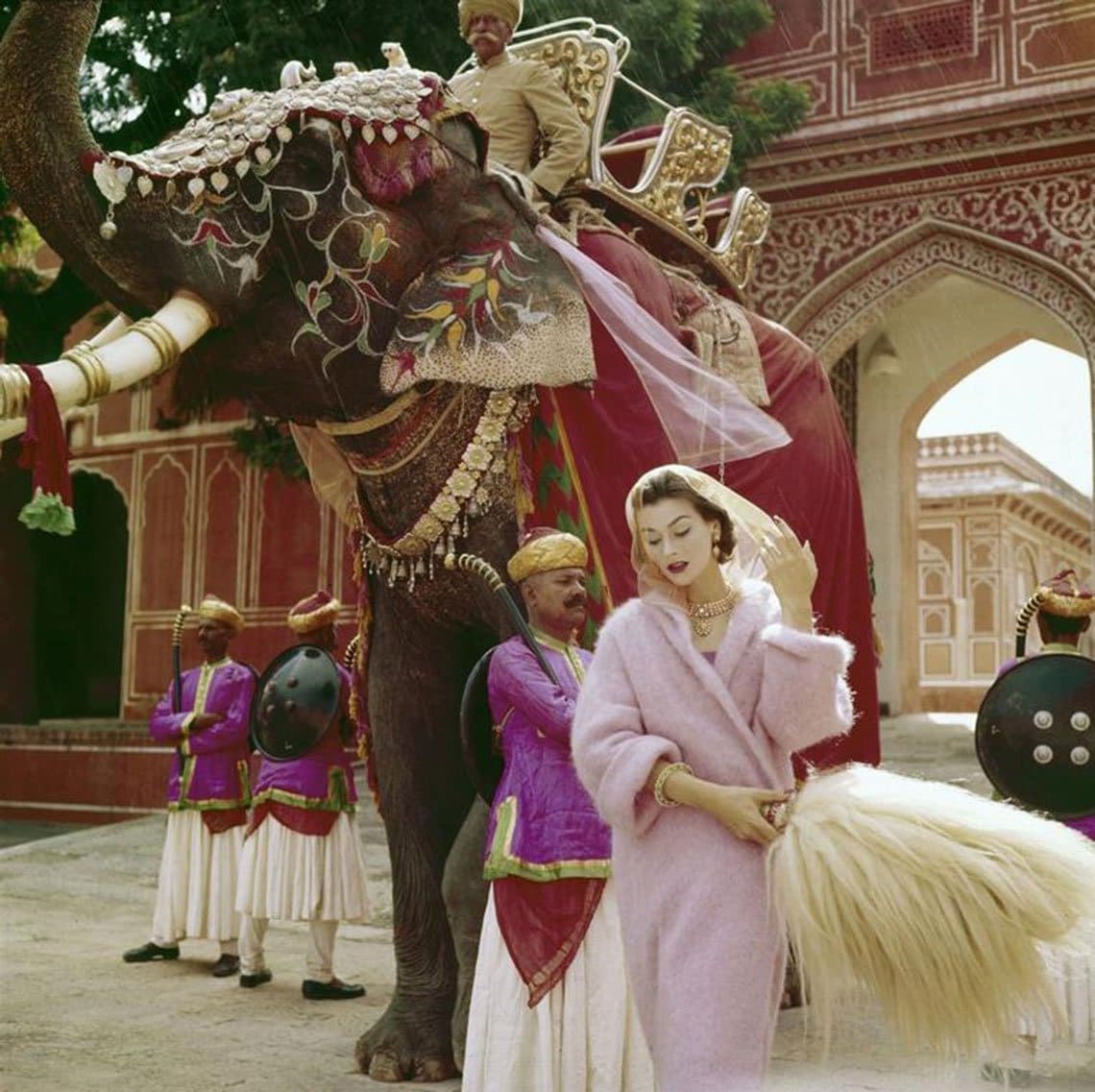The 1956 Vogue photograph of Anne Gunning in a pink mohair coat, taken by Norman Parkinson outside the City Palace in Jaipur, has become an enduring icon of twentieth-century fashion photography.
Commissioned for a magazine synonymous with aspirational modernity, the image exemplifies Vogue’s mid-century project of merging couture with cosmopolitan travel. As Carol Squiers has argued, fashion photography does not merely record clothes but creates a “symbolic system of fantasy and desire” (Squiers, 1994, p. 19)1. Parkinson’s staging of Gunning in India positions fashion as a universal language while simultaneously drawing upon the exoticism of a postcolonial landscape.
The model as Modern Madonna
Anne Gunning, an Irish model celebrated for her aristocratic poise, is presented as more than a mannequin. In Parkinson’s composition, she assumes a statuesque stillness against the monumental backdrop of the City Palace. The pale pink of her mohair coat, delicate in tone and soft in texture, is set against the deep ochres and terracottas of Rajasthani architecture. The effect recalls the chromatic harmonies of Renaissance portraiture, where figures were often positioned against architectural grandeur to emphasise status and beauty. Roland Barthes would later describe fashion photography as “a system of signs” (Barthes, 1967, p. 12)2, and here the coat signifies not only material luxury but also cultural authority: the model becomes a secular icon of modern elegance.
‘Orientalism’ and the postcolonial backdrop
The choice of Jaipur as setting is central to the photograph’s power. Edward Said’s Orientalism (1978)3 famously outlined how Western representations of the “East” functioned as imaginative geographies, constructing otherness in order to stabilise Western identity. Parkinson’s image participates in this discourse. India is mobilised not as subject but as backdrop: its architecture and colour serve to heighten the glamour of European fashion.
Yet the photograph also reflects historical transition. Less than a decade after Indian independence, Vogue’s staging of couture in Jaipur represents both continuity with colonial fantasy and a rearticulation of fashion as global. As Christopher Breward notes, mid-century fashion photography increasingly sought “worldly modernity through the circulation of images across geographies” (Breward, 2003, p. 88)4.
Parkinson’s painterly eye
Unlike studio-based contemporaries, Parkinson pioneered location shooting, using space as an active participant in the image. His Jaipur series exemplifies his painterly sensibility: careful balancing of architectural form and human figure, use of colour as symbolic contrast, and elevation of the model to sculptural presence. Martin Harrison has described Parkinson’s style as “a fusion of documentary immediacy and pictorial elegance” (Harrison, 1994, p. 75)5. In the Gunning photograph, this synthesis is evident: fashion becomes at once reportage, art object, and cultural performance.
Fashion, place, and cultural imagination
Today, the photograph endures because of its layered readings. It is both a record of mid-century couture and an artefact of cultural imagination, where fashion and architecture, East and West, modernity and tradition intersect. As Vogue constructed its vision of post-war femininity—cosmopolitan, elegant, and worldly—Parkinson’s Jaipur image crystallised this fantasy in visual form. Anne Gunning in a pink mohair coat outside the City Palace is thus more than a fashion plate: it is a visual negotiation of beauty, power, and place at a pivotal moment in fashion history.
References
- Squiers, C. (1994). The Critical Image: Essays on Contemporary Photography. Seattle: Bay Press. ↩︎
- Barthes, R. (1967). The Fashion System. New York: Hill and Wang. ↩︎
- Said, E. (1978). Orientalism. New York: Pantheon. ↩︎
- Breward, C. (2003). Fashion. Oxford: Oxford University Press. ↩︎
- Harrison, M. (1994). Appearances: Fashion Photography Since 1945. London: Jonathan Cape. ↩︎






